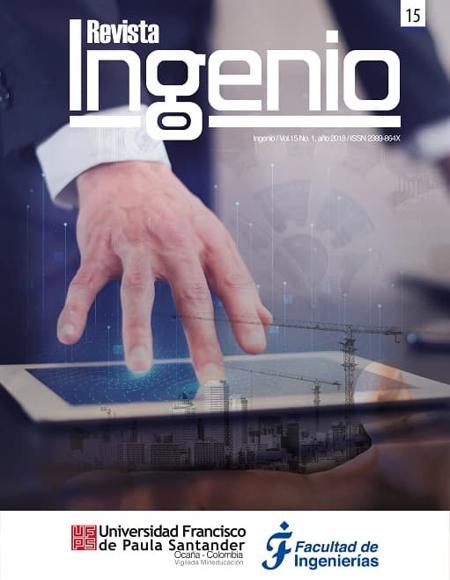Estudio numérico del proceso de cocción de ladrillos al interior de un horno tipo Hoffman
Numerical study of burning brick inside Hoffman kiln
Contenido principal del artículo
El aumento en la demanda energética y las emisiones contaminantes, así como la dependencia de los combustibles fósiles a nivel mundial, genera la necesidad de buscar estrategias enfocadas en una mayor eficiencia y mejoramiento en los procesos de transformación energética. En este estudio se evaluó numéricamente el proceso de cocción de ladrillos al interior de un horno tipo Hoffman, utilizando un enfoque de dinámica de fluidos computacionales (CFD), analizando los campos de temperatura y los patrones fluidodinámicos al interior del proceso. Los resultados obtenidos además de analizar en detalle cómo se dan los fenómenos térmicos al interior del horno evidenciaron varios campos de estudio en los que se debe profundizar para lograr una mejora energética en la cocción de ladrillos y por tanto mayor eficiencia.
Descargas
Datos de publicación
Perfil evaluadores/as N/D
Declaraciones de autoría
Indexado en
- Sociedad académica
- Universidad Francisco de Paula Santander
- Editorial
- Universidad Francisco de Paula Santander
Detalles del artículo
2016 IEO, International Energy Outlook 2016. U.S. Department of Energy, 2016.
L. Balza, R. Espinasa, and T. Serebrisky, Lights On?: Energy Needs in Latin America and the Caribbean to 2040. Inter-American Development Bank, 2016.
Agencia Internacional de Energía, “Recomendaciones de Políticas de Eficiencia Energética Regionales,” 2014.
Research and Innovation in Advanced Combustion of Industrial Use - INCOMBUSTION, “Determinación del potencial de reducción del consumo energético en los subsectores manufactureros códigos CIIU 10-18.” UPME, p. 209, 2014,http://www.upme.gov.co/Estudios/2014/INFORME_III_Caracterizacion_energetica_VerPub.pdf.
A. Amell, L. Rubio, Y. Cadavid, and C. Echeverri, “Informe final del proyecto: Evaluación de las necesidades tecnológicas y planes de acción tecnológica para mitigación del cambio climático.” Ministerio de Medio Ambiente y Desarrollo Sostenible, 2013.
J. Campos, E. Lora, L. Meriño, I. Tovar, and A. Navarro, “Ahorro de energía en la industria cerámica,” Un Proy. la unidad planeación Min. energética Colomb. y el Inst. Colomb. para el Desarro. la Cienc. y la Tecnol. Fr. Jose Caldas (Colciencias).(2014, octubre), 2010.
T. S. Possamai, R. Oba, and V. P. Nicolau, “Numerical and experimental thermal analysis of an industrial kiln used for frit production,” Applied Thermal Engineering, vol. 48, pp. 414–425, Dec. 2012, doi: 10.1016/j.applthermaleng.2012.05.025.
C. A. G. Ubaque, J. C. M. Piraján, and M. L. V. Bohórquez, “Incineración de residuos sólidos municipales en hornos ladrilleros tipo Hoffman: simulación y análisis del flujo de gases,” Tecnura, vol. 16, pp. 163–172, 2012.
Y. Tu, H. Liu, S. Chen, Z. Liu, H. Zhao, and C. Zheng, “Effects of furnace chamber shape on the MILD combustion of natural gas,” Applied Thermal Engineering, vol. 76(0), pp. 64–75, 2015, doi: 10.1016/j.applthermaleng.2014.11.007.
Y. J. Liu, J. D. Li, R. D. K. Misra, Z. D. Wang, and G. D. Wang, “A numerical analysis of slab heating characteristics in a rolling type reheating furnace with pulse combustion,” Applied Thermal Engineering, vol. 107, pp. 1304–1312, Aug. 2016, doi: 10.1016/j.applthermaleng.2016.07.074.
G. Guerrero Gómez, “Hornos de combustión: alternativas de reducción de emisiones e incremento de rentabilidad,” Bucaramanga: Universidad De Santander, 2017.
H. Meng, G. Zhu, Y. Yu, Z. Wang, and J. Wu, “The effect of symmetrical perforated holes on the turbulent heat transfer in the static mixer with modified Kenics segments,” International Journal of Heat and Mass Transfer, vol. 99, pp. 647–659, Aug. 2016, doi: 10.1016/J.IJHEATMASSTRANSFER.2016.03.110.
S. A. Jácome Manzano, “Evaluación termodinámica del proceso de cocción y análisis de gases en hornos a cielo abierto y Hoffman en Ocaña (Universida),” 2012.
T. Ishii, C. Zhang, and Y. Hino, “Numerical study of the performance of a regenerative furnace,” Heat Transf. Eng., vol. 23(4), pp. 23–33, 2002, doi: 10.1080/01457630290090473.
T. L. Bergman, F. P. Incropera, D. P. DeWitt, and A. S. Lavine, Fundamentals of heat and mass transfer. John Wiley & Sons, 2011.
A. Tehzeeb, M. Bhuiyan, and N. Jayasuriya, “Evaluation of brick Kiln performances using computational fluid dynamics (CFD),” Energy Environ. Eng., vol. 1(2), pp. 86–93, 2012.
W. Ratanathavorn, S. Charoenjai, S. Janbuala, B. Chalermsinsuwan, and K. Poochinda, “Effects of Design Parameters for Clay Brick Kiln Using Computational Fluid Dynamics and Experimental Design.,” Adv. Mater. Res., vol. 1101, 2015.
A. Beyene, R. Venkata, and S. Getachew, “CFD Simulation of Biogas Fired Clay Brick Kiln,” Am. J. Eng. Appl. Sci., vol. 11(2), pp. 1045–1061, 2017.
S. Defaee Rad, A. Ashrafizadeh, and M. Nickaeen, “Numerical simulation of fluid flow and heat transfer in an industrial continuous furnace,” Applied Thermal Engineering., vol. 117, pp. 263–274, May 2017, doi: 10.1016/J.APPLTHERMALENG.2017.02.031.
O. Díaz-Ibarra, P. Abad, and A. Molina, “Design of a day tank glass furnace using a transient model and steady-state computation fluid dynamics,” Applied Thermal Engineering, vol. 52(2), pp. 555–565, Apr. 2013, doi: 10.1016/J.APPLTHERMALENG.2012.11.018.
C. Lezcano, J. Obando, and A. Amell, “Numerical simulation of a flameless combustion furnace with mixtures of methane and a sub-bituminous pulverized Coal,” Combust. Sci. Technol., vol. 189(9), pp. 1591–1604, 2017, doi: 10.1080/00102202.2017.1305370.
G. Guerrero-Gómez, E. Espinel-Blanco, & T. Velásquez-Pérez, “Análisis isocinético y corrección a condiciones de referencia en horno a cielo abierto en el municipio de Ocaña, Norte de Santander”, Revista Ingenio, vol. 14(1), pp. 43–51, jul. 2017. Doi: https://doi.org/10.22463/2011642X.2194









